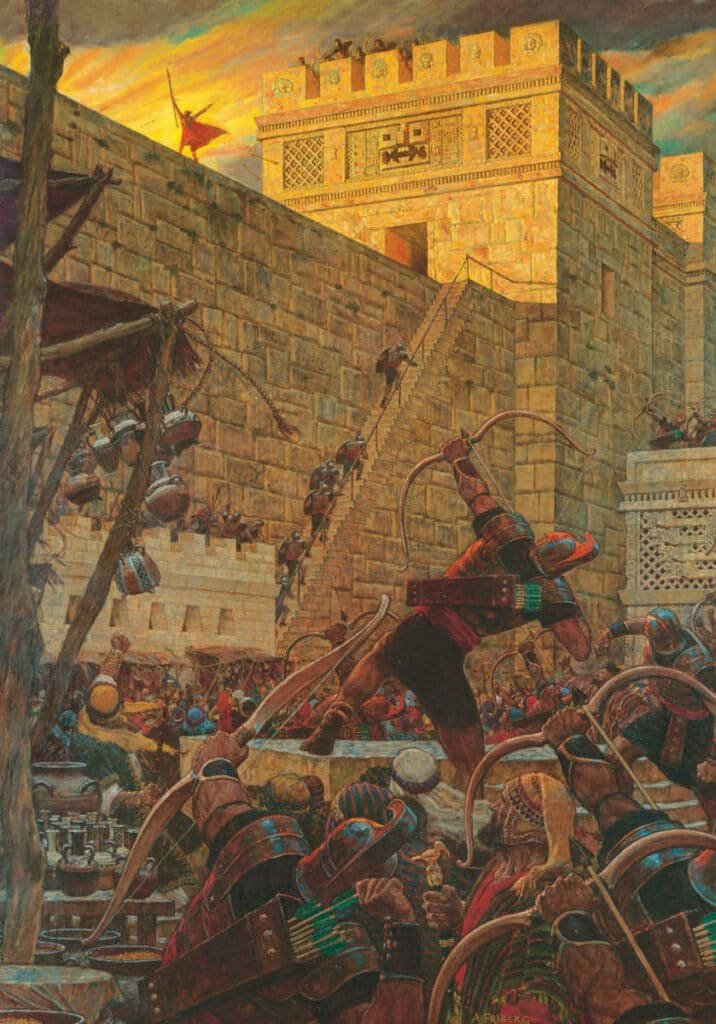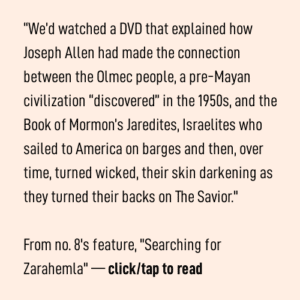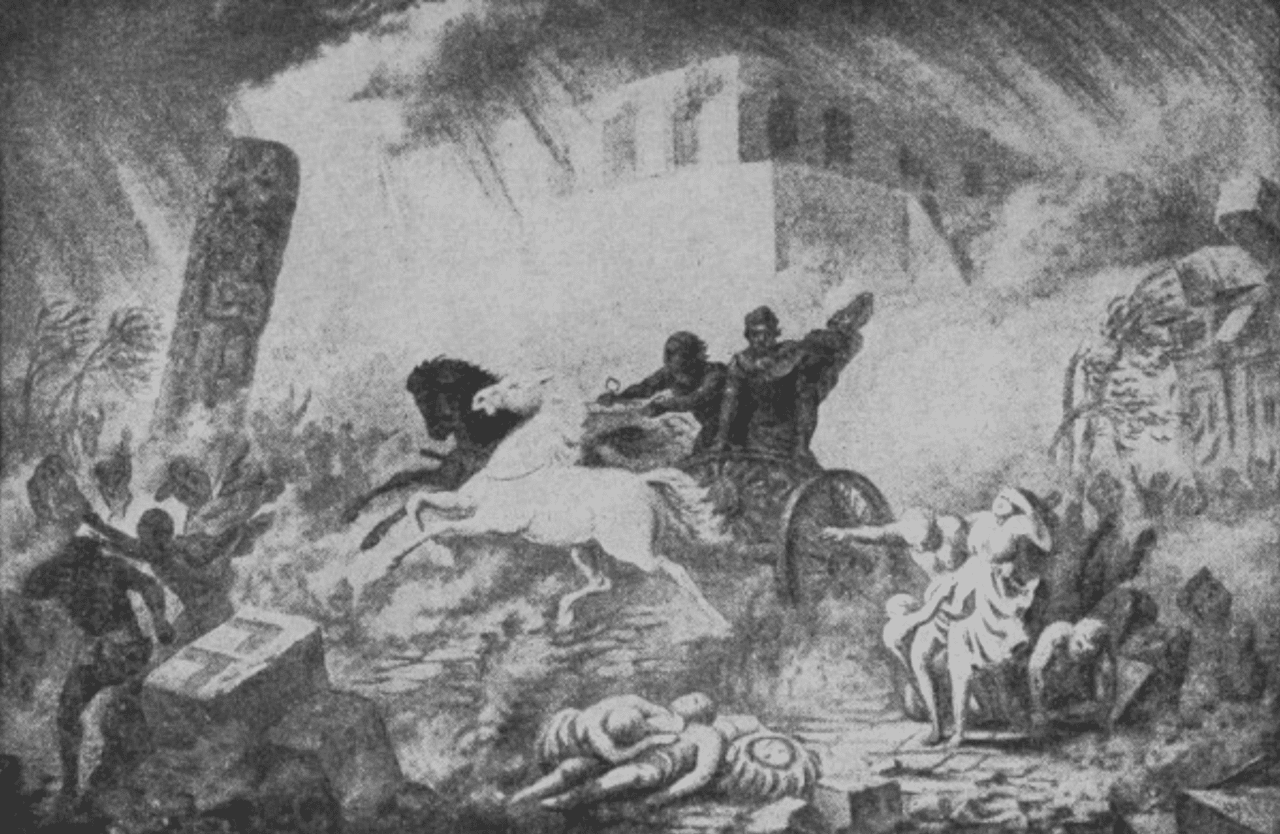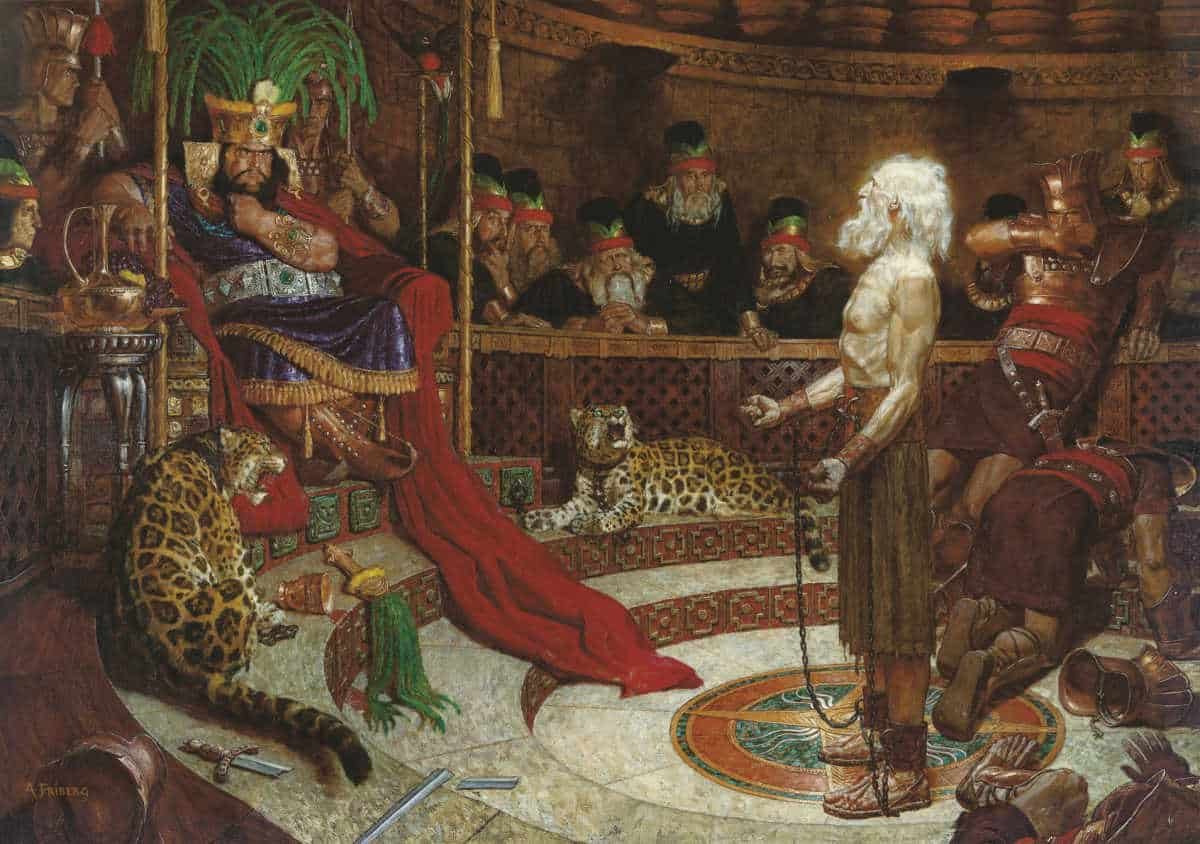Darren Longman
no. 8, The Road Trip Issue
Autumn 2022
And then shall they assist my people that they may be gathered in, who are scattered upon all the face of the land, in unto the New Jerusalem. And then shall the power of heaven come down among them; and I also will be in the midst.”
—3 Nephi 21:22-25
Studying in the Benson Latin American Collection at UT Austin was one of the most enriching experiences of my graduate program. As an art history student focused on artworks of the Late Classic Maya (600-900 CE), I spent significant time in the Rare Books room flipping through a copy of John Lloyd Stephens’s Incidents of Travel in Central America, Chiapas and Yucatán. Published in 1841, the work is an exhaustive account of the author’s expeditions to several unexcavated Maya sites. Frederick Catherwood’s illustrations for the book offered me a valuable look at Maya architecture and monuments — the subjects of my graduate research — before an additional 165 years of deterioration.
Of course, as a former member of The Church of Jesus Christ of Latter-Day Saints (Latter-day Saints or the Church, for shorthand), Catherwood’s drawings weren’t my first exposure to images inspired by 19th-century Maya archaeology.

My first copy of the Book of Mormon included several printed inserts of Arnold Friberg’s Book of Mormon paintings (1952-55), which melded Classical figurative styles, “exotic” landscapes, and art of the ancient Americas to visualize and validate the book’s narrative. I absorbed the parabolic teachings of Nephi, Abinadi, Samuel, and Captain Moroni through Friberg’s dynamic visuals, in which spiritual iconography, superhero-esque bodies, and Mesoamerican environments predominate. In his Samuel the Lamanite on the Wall, the prophet Samuel perches on a stone wall calling the wicked inhabitants of Zarahemla to repentance before the resurrection of Christ and His visit to the Americas. The composition zigzags between figures, staircases, and walls to bring the viewer’s eye perpetually to the prophet. The color palette is relatively muted except for rhythmic hints of red and quetzal green — a clear reference to ancient Mesoamerican color schemes — while the stone face of the Maya rain god Chahk gazes toward the prophet from a large, sun-drenched structure to his left.
To be sure, the Mesoamerican iconography in Friberg’s paintings speaks to the broader form of ethnic violence propagated by “lost white tribes” myths, which gained traction in 18th to 20th-century pseudoscience. Around the time Joseph Smith founded the Church, some theories suggested that a “superior” race created ancient North American earthworks rather than Native Americans. A core aspect of the Book of Mormon, to that end, is that Indigenous groups of the Americas descended from the lost tribes of Israel. The Church’s pursuit of whiteness in the “New Jerusalem” was reinforced throughout the 19th and 20th centuries in theological, academic, and artistic programs.
The Not-So-Neutral History of Book of Mormon Geography
Today, the Church maintains a neutral position on where, specifically, Book of Mormon events took place. But it wasn’t always that way, and it certainly wasn’t that way when I was in Sunday School. The current leadership urges members to refrain from “personal theories” about these geographies, which feels an awful lot like gaslighting to scores of former members who were implicitly or explicitly taught that Central America was critical to the historicity of Christ’s visit to the “New World.”

This neutral position also belies the historical record of the Church itself. Immediately after the publication of the Book of Mormon, arguments about its geography were spread by prominent Latter-day Saints — including early founder Oliver Cowdery, who suggested that Lehi arrived on the coast of Chile. In 1841, however, Joseph Smith received a copy of Stephens/Catherwood’s Incidents of Travel and endorsed the book, saying that it, “corresponds with and supports the testimony of the Book of Mormon.” In 1842, Times and Seasons, a Latter-day Saint newspaper in Nauvoo, Illinois, published several articles featuring Catherwood’s images. The Central American geography theory was undoubtedly the most accepted among Church members for decades, and Mesoamerican motifs appear throughout 19th-century Latter-day Saint visual culture.
In 1888, the first official commentary of Joseph Smith’s manuscript, the Story of the Book of Mormon, was commissioned by General Authority George Reynolds. Meant to be a “picturesque” work that would help Church youth engage with their sacred text, it produced images consistent with Mesoamerican art, architecture, and hieroglyphic writing. Four artists from Salt Lake City, Utah, were commissioned to paint the illustrations, with George M. Ottinger contributing several pieces that directly reference Maya stone monuments and Mesoamerican temples. In Ottinger’s Destruction of Zarahemla, a group of iniquitous Nephites writhes in anguish as the city crumbles around them. The chaotic scene is punctuated with decorative monoliths, including a massive Maya stela falling toward the earth. The stela shares traits with others from sites like Copán, Honduras, but the rest of the tableau juxtaposes European figures and objects with exoticized inventions of the ancient Americas — a colonialist template of visual misrepresentation that was adopted by Latter-day Saint artists throughout the next century.

Palestinian-American scholar Edward Said was one of the first to suggest that 19th-century European artists perpetuated stereotypical and fixed ideas of the “Orient” as an “overly sexual,” “decadent,” and “barbaric” region. Similarly, Latter-day Saint painters often engaged in a complex visual exoticism — compiling or merging elements of the Biblical world, Western colonialist paintings, and ancient Mesoamerica to illustrate Book of Mormon events. In Arnold Friberg’s Abinadi before King Noah, several cultural expressions collide to visualize a scene from the book of Mosiah in which King Noah imprisoned the prophet Abinadi for calling the kingdom to repent. The bound prophet stands with the utmost strength and courage while preaching to the defiant Noah, who sits on a throne surrounded by growling jaguars, drunken soldiers, and conspiring high priests.
But the source material — the Book of Mormon — barely describes the scene’s particulars, mentioning only construction materials (wood, copper, brass, and gold). Most of the figures and motifs in the work are inventions from Friberg’s imagination coupled with a hodgepodge of multicultural references. King Noah’s royal regalia includes exceedingly pointy shoes that call to mind ancient western Asian boots; the high priests wear cylindrical headdresses like those worn by the Assyrian elites of Babylon. The shackled Abinadi, by contrast, appears as a humble (and white) servant of God — replete with tattered clothing, a long (white) beard, and, of course, a ripped physique that links the wise prophet to Classical humanist (white) idealism. The work embodies the ethnocentric through-line of the Book of Mormon narrative where, in most cases, whiteness is tantamount to righteousness and brownness to iniquity.

Friberg also dropped Mesoamerican motifs into the composition with brazen incoherence. The base of Noah’s throne contains jade medallions with pseudo-signs derived from Maya hieroglyphs; they say absolutely nothing. A fan with green quetzal feathers leads the eye down to a step filled with Mesoamerican quatrefoils, which in a Maya context denote otherworldly portals. King Noah wears a Fribergian variation of an Aztec headdress with quetzal feathers sprouting upward before falling toward a squawking quetzal bird.
Latter-day Saint artists in the 21st century continue to use Mesoamerican concepts to imagine the “New World” according to the Book of Mormon narrative. In Simon Dewey’s Christ in the Land Bountiful (2010), a group of Nephites — who look to me an awful lot like contemporary Utahns — feel the crucifixion marks on Christ’s hands and feet. The scene plays out in a lush jungle with stepped temples that mirror those in Mesoamerican regions. Like Freiberg’s work, it combines artistic naturalism with dashes of Biblical familiarity and indigenous elements to validate the Book of Mormon as a historical document couched in ancient American geography.
The Not-So-Harmless Reality of Book of Mormon Imagery
Aren’t these just innocuous paintings that depict the personal theories of individual artists? Maybe. But artistic production is one of the most effective ways that cultures construct, spread, and internalize ideologies.
Brigham Young University professor Anthony Sweat does an experiment with his students: he asks them to close their eyes and imagine the story of Noah and Abinadi. The students often envision the story exclusively through Friberg’s painting, even shouting “Leopards!” (for the jaguars) when asked which animals King Noah has as pets. Sweat stated, “It’s an image with such influence and widespread distribution that it has shaped these artistic interpretations into almost certain facts for an entire generation of church members.” In other words, the Book of Mormon stories and their visual counterparts are viewed as historically accurate and thus provide the ontological framework for how members perceive these groups and geographies — including those in ancient Mesoamerica.
One might assume I picked Mesoamerican research because of my former membership in the Church. But it wasn’t Friberg’s vision that propelled my interest; it was the complex and dynamic works of Maya, Mixtec, Zapotec, and Mexica artists. That said, I spent a great deal of my life subscribing to the Church’s version of the “lost white race” theory and, when choosing my field, felt a strong sense of responsibility to study and discuss this world from a completely different perspective. Never was this more apparent to me than when I sat in the Benson Library, pouring over Catherwood’s Maya sketches. The palimpsestic traces of Book of Mormon images faded into memory, and I realized just how much this internalized vision of Mesoamerica — first promoted to me as a child — shaped my self-perception and deep-seated worldviews. My work as an art historian isn’t necessarily about interpreting historical images, making ground-breaking discoveries, or inventing new theories. Rather, it’s about nurturing an ongoing practice of self-examination to challenge inner preconceived philosophies and boost culturally-conscious visual literacy.
“Book of Mormon Geographies,” online at churchofjesuschrist.com.
“John Bernhisel’s Gift to a Prophet: Incidents of Travel in Central America and the Book of Mormon” by Matthew Roper in Interpreter: A Journal of Latter-Day Saint Faith and Scholarship 16.
‘”A Picturesque and Dramatic History’: George Reynolds’s ‘Story of the Book of Mormon’” by Noel Carmack in Brigham Young University Studies 47, no. 2.
“Exotic Harem Paintings: Gender, Documentation, and Imagination” by Julia Kuehn in Frontiers: A Journal of Women Studies 32, no. 2.
“Mormon ‘Gospel Art’: Kitsch or Classic?” by Kimberly Winston in Religion News Service.
Darren Longman is an art historian and professor at Lone Star College in Texas, where his research centers on interdisciplinary approaches to Mesoamerican studies, including art historical, anthropological, and philosophical methodologies.

More great reading
from Pipe Wrench no. 8
Searching for Zarahemla
Journalist Emily Fox Kaplan recounts an epic Mormon road trip across Mesoamerica. How many ways are there to tell a story? And how do we know what’s true?
The Traditions of the Fathers
Anthropologist Catherine Nuckols-Wilde casts a critical eye at Mormon archeological scholarship and its impact on how the West sees Mesoamerica.
The Ethics of Religious Appropriation, Turned Back On Us
Ethicist Liz Bucar looks at how we approach religions that aren’t ours. We can study them and write about them. What we can’t do is recoil.
